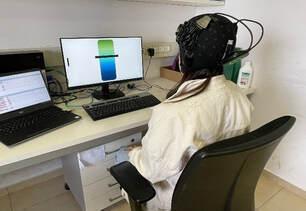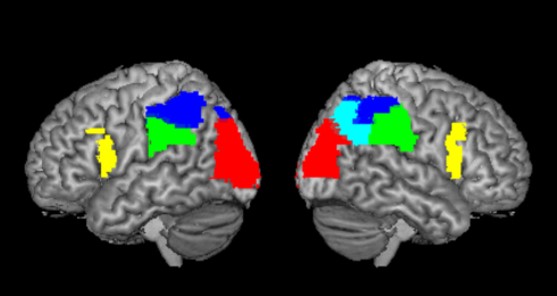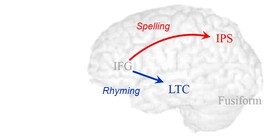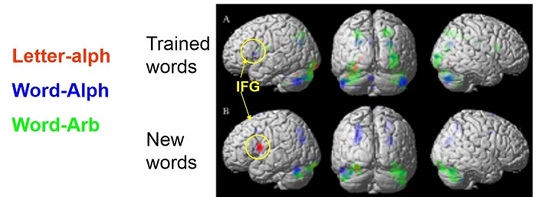Learning a second language
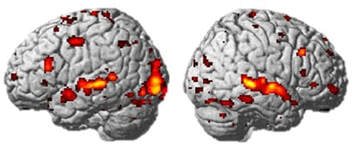
First language affects brain mechanisms involved in learning a novel language:
Learning a second language may be easier when it is similar in structure to the first language. We suggest that this may be due to the effect of prior knowledge on consolidation processes. Together with Prof. James Booth, from Vanderbilt University we use fMRI to compare native Hebrew and English speakers on how they learn an artificial morpho-lexicon.
Learning a second language may be easier when it is similar in structure to the first language. We suggest that this may be due to the effect of prior knowledge on consolidation processes. Together with Prof. James Booth, from Vanderbilt University we use fMRI to compare native Hebrew and English speakers on how they learn an artificial morpho-lexicon.

Sleep dependent consolidation of morphological inflections in children and adults, with and without dyslexia:
Children are expected to acquire a second language more easily than adults, but the underlying mechanisms for this advantage are still unknown. We examined the effect of age on sleep dependent consolidation when learning morphological inflections in an artificial language. Our results show more robust consolidation processes in children, which are independent of sleep, while adults showed weaker consolidation effects and they were more affected by sleep. We also found that prior knowledge in the first language predicted early consolidation of the novel language.
Children are expected to acquire a second language more easily than adults, but the underlying mechanisms for this advantage are still unknown. We examined the effect of age on sleep dependent consolidation when learning morphological inflections in an artificial language. Our results show more robust consolidation processes in children, which are independent of sleep, while adults showed weaker consolidation effects and they were more affected by sleep. We also found that prior knowledge in the first language predicted early consolidation of the novel language.
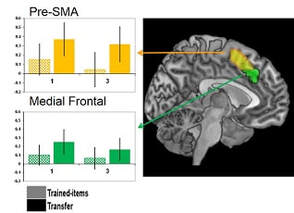
The neurocognitive mechanisms underlying learning morphological inflections in a novel language:
Learning of new morphological inflections can serve as a model for studying the learning mechanisms underlying the acquisition of language skills. We used an artificial oral language and fMRI to study the effect of statistical factors on the mechanisms involved in the acquisition of plural inflections. We found that the inflection frequency and its phonological diversity critically affect the brain mechanisms involved in its acquisition. We also found very early involvement of procedural learning mechanisms in learning of regularities in the novel language.
Learning of new morphological inflections can serve as a model for studying the learning mechanisms underlying the acquisition of language skills. We used an artificial oral language and fMRI to study the effect of statistical factors on the mechanisms involved in the acquisition of plural inflections. We found that the inflection frequency and its phonological diversity critically affect the brain mechanisms involved in its acquisition. We also found very early involvement of procedural learning mechanisms in learning of regularities in the novel language.
rehabilitation
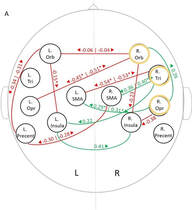
Brain connectivity in post-stroke patients with aphasia:
Patients with acquired brain lesions suffering from Aphasia often have disrupted brain connectivity within and between hemispheres. In a study done in collaboration with Dr. Jed Meltzer from the Rotman-Baycrest Research Institute we found that excitatory right to left connectivity at the level of the auditory cortex is associated with good recovery. In a treatment study with Prof. Elizabeth Rochon from the University of Toronto we found increased Resting State connectivity between right language areas and motor speech control areas following melody-based therapy. We are currently testing the effect of morphology based treatment for Hebrew speakers with aphasia on brain connectivity.
Patients with acquired brain lesions suffering from Aphasia often have disrupted brain connectivity within and between hemispheres. In a study done in collaboration with Dr. Jed Meltzer from the Rotman-Baycrest Research Institute we found that excitatory right to left connectivity at the level of the auditory cortex is associated with good recovery. In a treatment study with Prof. Elizabeth Rochon from the University of Toronto we found increased Resting State connectivity between right language areas and motor speech control areas following melody-based therapy. We are currently testing the effect of morphology based treatment for Hebrew speakers with aphasia on brain connectivity.
Executive control training in patients with traumatic brain injury:
Patients with traumatic brain injury often have deficits in executive control functions such as inhibition and working memory. Existing cognitive rehabilitation methods typically have limited treatment outcomes. We try to apply basic learning principles, taken from the fields of motor and language learning and consolidation on healthy individuals, to the study of cognitive rehabilitation, in order to improve maintenance and generalization of treatment outcomes.
Patients with traumatic brain injury often have deficits in executive control functions such as inhibition and working memory. Existing cognitive rehabilitation methods typically have limited treatment outcomes. We try to apply basic learning principles, taken from the fields of motor and language learning and consolidation on healthy individuals, to the study of cognitive rehabilitation, in order to improve maintenance and generalization of treatment outcomes.
|
Neurofeedback
One potential way to enhance the effects of cognitive training is providing participants with feedback on the level of their brain activation in order to enhance their control in modulating the level of activation in specific brain regions. We use fNIRS to measure changes in brain activation and connectivity during working memory training, in order to use this signal during neurofeedback. |
reading
|
Hebrew:
The enormous malleability of the nervous system suggest that the neurocognitive mechanisms involved in reading depend on the properties of the specific language and the readers’ experience with its orthography. Hebrew provides a unique opportunity to study the effect of orthographic transparency (diacritic marks and vowel letters) and morphological complexity (roots and templates) on the brain of skilled and non- skilled (young or dyslexic) readers. Our results show a critical effect for the reader’s experience, that overrides the effect of orthographic transparency. We also find that young and dyslexic Hebrew readers tend to rely more on morphological segmentation compared to skilled readers, which may help compensate for their poor phonological skills. |
|
English:
Children acquiring reading in English have to master the irregularity of the writing system. In collaboration with the lab of James Booth, at Northwestern University, we studied developmental changes in brain connectivity while children learn to cope with conflicting orthographic and phonological information. Using an analysis method for looking at directional interactions among brain regions (Dynamic Causal Modeling) we identified task specific convergence zones integrating top-down and bottom-up influences. We have also shown a developmental increase in top-down control processes, providing an account for children’s greater susceptibility to distractions from irrelevant information. The same analysis technique enabled us to look at inter-hemispheric connectivity, showing reciprocal influences between hemispheres which were greater for girls compared to boys. These finding can explain some of the behavioral evidence for sex differences in language ability. |
|
An artificial Orthography:
We use an artificial orthography to study the effect of the readers experience on the brain mechanisms involved in learning to read. The comparison or explicit and implicit instruction methods, in our earlier studies, showed that different instruction methods resulted in differential reliance on procedural learning, and that only explicit instruction on the smallest repeating units in the words resulted in improved consolidation after the end of training. Our recent study has showed that a variable set of trained items results in better learning, demonstrating a critical role for the statistical properties of the input for determining the content and process involved in learning. |

